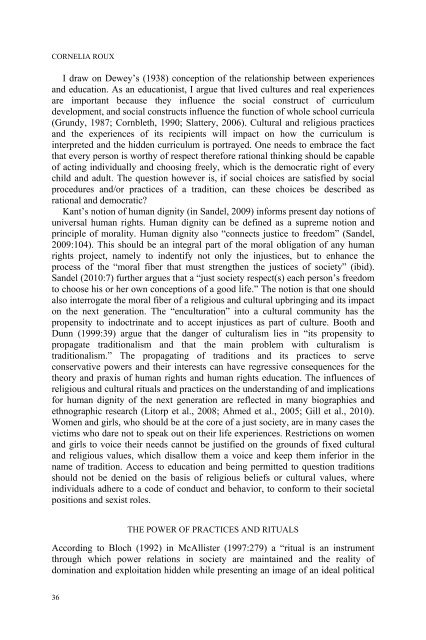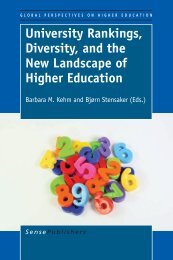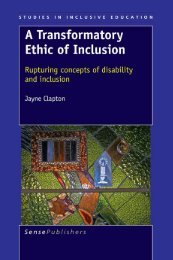Safe Spaces Human Rights Education in Diverse Contexts
Safe Spaces Human Rights Education in Diverse Contexts
Safe Spaces Human Rights Education in Diverse Contexts
You also want an ePaper? Increase the reach of your titles
YUMPU automatically turns print PDFs into web optimized ePapers that Google loves.
CORNELIA ROUX<br />
I draw on Dewey’s (1938) conception of the relationship between experiences<br />
and education. As an educationist, I argue that lived cultures and real experiences<br />
are important because they <strong>in</strong>fluence the social construct of curriculum<br />
development, and social constructs <strong>in</strong>fluence the function of whole school curricula<br />
(Grundy, 1987; Cornbleth, 1990; Slattery, 2006). Cultural and religious practices<br />
and the experiences of its recipients will impact on how the curriculum is<br />
<strong>in</strong>terpreted and the hidden curriculum is portrayed. One needs to embrace the fact<br />
that every person is worthy of respect therefore rational th<strong>in</strong>k<strong>in</strong>g should be capable<br />
of act<strong>in</strong>g <strong>in</strong>dividually and choos<strong>in</strong>g freely, which is the democratic right of every<br />
child and adult. The question however is, if social choices are satisfied by social<br />
procedures and/or practices of a tradition, can these choices be described as<br />
rational and democratic?<br />
Kant’s notion of human dignity (<strong>in</strong> Sandel, 2009) <strong>in</strong>forms present day notions of<br />
universal human rights. <strong>Human</strong> dignity can be def<strong>in</strong>ed as a supreme notion and<br />
pr<strong>in</strong>ciple of morality. <strong>Human</strong> dignity also “connects justice to freedom” (Sandel,<br />
2009:104). This should be an <strong>in</strong>tegral part of the moral obligation of any human<br />
rights project, namely to <strong>in</strong>dentify not only the <strong>in</strong>justices, but to enhance the<br />
process of the “moral fiber that must strengthen the justices of society” (ibid).<br />
Sandel (2010:7) further argues that a “just society respect(s) each person’s freedom<br />
to choose his or her own conceptions of a good life.” The notion is that one should<br />
also <strong>in</strong>terrogate the moral fiber of a religious and cultural upbr<strong>in</strong>g<strong>in</strong>g and its impact<br />
on the next generation. The “enculturation” <strong>in</strong>to a cultural community has the<br />
propensity to <strong>in</strong>doctr<strong>in</strong>ate and to accept <strong>in</strong>justices as part of culture. Booth and<br />
Dunn (1999:39) argue that the danger of culturalism lies <strong>in</strong> “its propensity to<br />
propagate traditionalism and that the ma<strong>in</strong> problem with culturalism is<br />
traditionalism.” The propagat<strong>in</strong>g of traditions and its practices to serve<br />
conservative powers and their <strong>in</strong>terests can have regressive consequences for the<br />
theory and praxis of human rights and human rights education. The <strong>in</strong>fluences of<br />
religious and cultural rituals and practices on the understand<strong>in</strong>g of and implications<br />
for human dignity of the next generation are reflected <strong>in</strong> many biographies and<br />
ethnographic research (Litorp et al., 2008; Ahmed et al., 2005; Gill et al., 2010).<br />
Women and girls, who should be at the core of a just society, are <strong>in</strong> many cases the<br />
victims who dare not to speak out on their life experiences. Restrictions on women<br />
and girls to voice their needs cannot be justified on the grounds of fixed cultural<br />
and religious values, which disallow them a voice and keep them <strong>in</strong>ferior <strong>in</strong> the<br />
name of tradition. Access to education and be<strong>in</strong>g permitted to question traditions<br />
should not be denied on the basis of religious beliefs or cultural values, where<br />
<strong>in</strong>dividuals adhere to a code of conduct and behavior, to conform to their societal<br />
positions and sexist roles.<br />
36<br />
THE POWER OF PRACTICES AND RITUALS<br />
Accord<strong>in</strong>g to Bloch (1992) <strong>in</strong> McAllister (1997:279) a “ritual is an <strong>in</strong>strument<br />
through which power relations <strong>in</strong> society are ma<strong>in</strong>ta<strong>in</strong>ed and the reality of<br />
dom<strong>in</strong>ation and exploitation hidden while present<strong>in</strong>g an image of an ideal political














